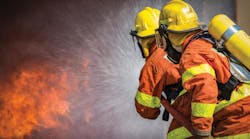OSHA put its Combustible Dust National Emphasis Program into place over 10 years ago. Since then, new NFPA standards on combustible dust have been issued, OSHA’s plan for a comprehensive Combustible Dust Standard has been quietly tabled, and combustible dust incidents continue to occur.
Safety professionals recognize the potential hazards of combustible dust. However, OSHA has left its National Emphasis Program (NEP) vague in many ways, and this presents a challenge. OSHA has kept the NEP in place. They continue to issue citations based on already existing standards.
Where does this leave companies with possible combustible dust issues? It’s important to understand best practices for combustible dust safety, as well as the pre-existing OSHA standards that form the basis of the NEP.
WHAT IS A NATIONAL EMPHASIS PROGRAM?
OSHA can implement a National Emphasis Program any time there seems to be a developing or ongoing problem with worker health and safety. These programs are put into place when a situation requires special attention to protect people.
OSHA can issue National, Regional and Local Emphasis Programs. A Local or Regional Program may be targeted toward a particular issue that tends to be located in certain areas (e.g., oil and gas industries or marine operations). A National Program addresses nationwide hazards. Combustible dust accidents occur in many different industries all over the country.
With an NEP in place, industries that fall under the program’s issue of concern can expect to see more inspections. The combustible dust NEP allows OSHA to inspect facilities in any industry where combustible dust could be a hazard. However, an emphasis program is not a standard or a law. OSHA cannot specifically cite a company for violations of the combustible dust NEP.
However, the NEP allows OSHA inspectors to focus on potential combustible dust hazards, and while there’s no standard to fine a company for a combustible dust problem, many other standards can be used to enforce combustible dust safety.
WHICH STANDARDS ARE ENFORCED UNDER THE NATIONAL EMPHASIS PROGRAM?
The combustible dust NEP is still in place. Currently, OSHA fines from these inspections have fallen under several general categories:
• 1910.22 General Housekeeping
• 1910.94 Ventilation and Environmental Control
• 1910.305 Electrical Safety
• 1910.1200 Hazard Communication
• 1910.134 Respiratory Protection
• Section 5(a)(1) General Duty Clause.
The General Duty Clause states that companies are required to provide a safe, healthy workplace for employees. While almost any health or safety hazard could be cited under this clause, most of the citations resulting from the NEP come from other standards. Grain handling facilities are covered by their own standard, since historically grain and agricultural products have been recognized as an explosion hazard.
The Chemical Safety Board (CSB), an independent government body investigating industrial incidents, has called on OSHA to institute a universal combustible dust standard for over a decade. They report that from 2006 to 2017, food product industries generated the highest level of incidents. However, metal and woodworking industries came in tied for a close second place. The first call for action on combustible dust came from the CSB in the wake of a notorious sugar refinery explosion that killed 13 people in 2008. The most recent one came after a 2017 accident at a milling facility that killed five.
NFPA AND THE NATIONAL EMPHASIS PROGRAM
The National Fire Protection Association (NFPA) is a nonprofit organization that develops codes and standards for fire and explosion safety. The NFPA is not a regulatory group and does not conduct inspections or issue fines. However, their standards often guide other organizations. Many building codes and insurance companies use NFPA standards as legal requirements.
Although OSHA’s NEP on combustible dust is not an actual OSHA standard, inspectors have been encouraged to use NFPA standards to determine whether there are dust safety issues in a facility. The focus is on two of the newer NFPA standards: NFPA 625 Standard on the Fundamentals of Combustible Dust, and NFPA 654 Standard for the Prevention of Fire and Dust Explosions from the Manufacturing, Processing and Handling of Combustible Particulate Solids. Along with several industry-specific standards, other relevant ones include NFPA 68 Standard on Explosion Protection by Deflagration Venting and NFPA 69 Standard on Explosion Prevention Systems.
One of the new requirements for the NFPA’s combustible dust standards is a dust hazard analysis, which must be kept on record and presented to “the authority having jurisdiction.” Often, this applies to a local, county or state official who enforces building codes and fire safety inspections. Since OSHA does not have an official standard requiring a dust hazard analysis, they cannot demand a dust hazard analysis. However, there are OSHA standards for Process Hazard Analysis, and any dust-producing process should include combustible dust issues in this analysis.
WILL THERE BE AN OSHA COMBUSTIBLE DUST STANDARD?
When OSHA initiated the NEP on combustible dust in 2007, one stated goal was to move toward an enforceable combustible dust OSHA standard. In 2009, OSHA added this potential standard to a long list of standards awaiting review and discussion.
The intent to establish an enforceable combustible dust standard hit many roadblocks. First, a combustible dust standard would apply to many industries and processes, with huge differences between them. This standard would need to be applicable to all industries with combustible dust (the exceptions would include grain handling and mining, which have their own standards already). EHS
Jeremiah Wann is president and CEO of Imperial Systems (www.isystemsweb.com), a manufacturer of industrial air filtration equipment and industrial dust collection equipment.
